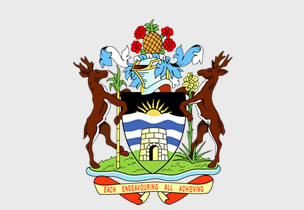Location
The tropical islands of Antigua and Barbuda are located in the heart of the Caribbean about a thousand miles to the east of Jamaica and half that distance from Trinidad on the coast of South America. We are at 17- N latitude, about the same as the Cape Verde Islands and Bombay and 61- W longitude.
The island of Antigua was born out of the sea by a volcano about 30 million years ago. A young island in geologic time. On the northern flank of this volcano, reefs were formed, hence the greater part of Antigua is low lying and is composed of limestone rock.
The highest point of Antigua is 1,319 ft in the south-west and is called Boggy Peak, but the limestone Highlands of Barbuda rise to only 125 ft. The area of Antigua is 108 square miles, while Barbuda is 62 square miles. The population of the former is approaching 80,000, but the latter is relatively unpopulated at 1,300. Days and nights are refreshingly cooled by the gentle trade winds. Antigua boasts the largest expanse of freshwater in the whole of the Caribbean with a lake nearly two miles long by a mile wide.
Barbuda became separated from Antigua by about 28 miles, when the sea-levels of the world rose considerably at about 10,000 BC. Today parts of Barbuda are geologically flooded to form interesting lagoons. Here may be seen the largest breeding and nesting colony of the Magnificent Frigate Bird in the world. Barbuda supports a tremendous diversity of native habitats, as yet unthreatened by development. Reef-fringed Barbuda may be one of the best kept ecological secrets in the West Indies. Her rugged scenery, beautiful beaches, (one at least 12 miles long), lagoons and abundant wildlife may be a resource as valuable as its fisheries.
Members:
Resources
Displaying 31 - 33 of 33Beach Control Act (Cap. 45).
The Act provides for the vesting of the foreshore and the floor of the sea in the Crown and regulates the use and control of those areas and related matters. The “floor of the sea” means the soil and subsoil of the sea off the coast of Antigua and Barbuda between the low water mark and so far out to sea as is deemed by law to be within the territorial sea (sect. 2). Use of the foreshore and the floor of the sea requires a licence.
Registered Land Act (No. 17 of 1975).
The Act makes provision for the registration of titles in land, effect of registration, protection of persons dealing in registered land, disposition of land or a title in land in general, acquisition of land or transfer of rights in land under certain titles such as prescription and easement, and related matters.The Act consists of 161 sections divided into 12 Parts: Preliminary (I); Organization and administration (II); Effect of registration (III); Certificate and searches (IV); Dispositions (V); Instruments and agents (VI); Transmissions and trusts (VII); Restraints on dispositions (VII
Beach Protection Act.
It shall not be lawful for any person to dig, take or carry away for building or construction purposes or for providing ballast for a vessel any sand, stone, gravel, etc. from any beach, seashore or floor or to move such materials along a public road, except under and in accordance with a permit from the Director of Public works. A permit shall be in the form as set out in the Schedule. No transport of such materials shall take place at night.
Amended by: Beach Protection (Amendment) Act (No. 6 of 1993). (1993-02-18)


